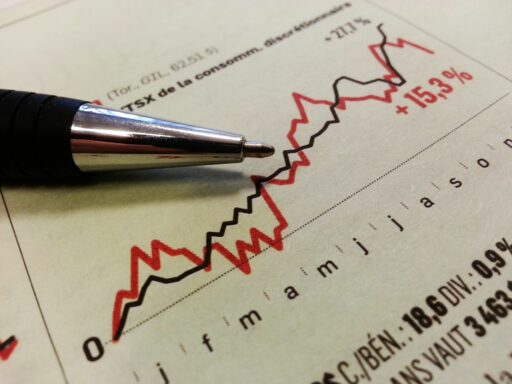Shopify’s stock (SHOP) has been a topic of interest among investors, with varied opinions from analysts and a range of signals from the market. Amidst the shifting tides of the e-commerce industry, Shopify’s performance and future prospects have come under scrutiny. This article delves into the current analyst ratings, financial performance, technical analysis, investor sentiment, and strategic considerations to discern whether Shopify stock is a buy, hold, or sell in today’s market.
Key Takeaways
- Wall Street analysts provide mixed signals, with a general consensus leaning towards a ‘hold’ or ‘moderate buy’ rating for Shopify stock.
- Shopify’s financial performance shows robust revenue growth, but there are concerns about the sustainability of its business model in the long term.
- Technical analysis reveals negative signals despite a positive trend, suggesting potential weakness in the stock in the near term.
- Investor sentiment is influenced by recent news, insider trading activity, and high-profile investors’ positions, with a general trend of selling shares.
- Potential investors should weigh the risk-reward balance carefully, considering analyst forecasts, market trends, and Shopify’s competitive edge before making an investment decision.
Current Analyst Ratings and Future Price Targets


Wall Street Analysts’ Consensus
In the dynamic landscape of today’s market, Shopify Inc. Class A Subordinate Voting Shares (SHOP) have been the subject of meticulous scrutiny by Wall Street analysts. The consensus among these experts provides a glimpse into the stock’s potential trajectory. Based on the latest data, the average price target for SHOP over the next 12 months stands at $81.45, with the spectrum of estimates ranging from a low of $65.00 to a high of $100.00.
The diversity in price targets reflects the varying degrees of optimism and caution among analysts, highlighting the importance of individual investment strategies and risk assessments.
The table below summarizes the current analyst ratings:
| Analyst / Firm | Rating | Price Target | Upside/Downside | Date |
|---|---|---|---|---|
| Piper Sandler | Buy | $75.00 | -7.91% | 2024-02-14 |
| DZ Bank AG | Strong Sell | $63.00 | -17.79% | 2024-02-14 |
| Morgan Stanley | Strong Buy | $85.00 | +10.92% | 2023-12-06 |
| Citigroup | Hold | $74.00 | -3.43% | 2023-12-04 |
Analyst recommendations range from ‘Strong Buy’ to ‘Strong Sell’, indicating a polarized view on the stock’s future performance. Investors are advised to consider these insights in the context of their own investment goals and risk tolerance.
Projected Stock Price Targets for 2024
As we look ahead to 2024, Shopify’s stock price targets present a mixed picture according to various analysts. The average stock price target is set at $76.16, with a high estimate of $110.00 and a low estimate of $50.00. This range indicates a potential downside of approximately 0.6%, suggesting that investors should temper their expectations for significant growth in the stock’s value. The consensus among analysts leans towards a ‘Hold’ rating, reflecting a cautious optimism about the stock’s future performance.
The projected price targets for Shopify’s stock in 2024 reveal a cautious stance from analysts, with a modest upside potential and a consensus that leans towards maintaining current positions.
Analysts’ coverage is extensive, with 38 analysts offering 12-month forecasts. The predicted upside of 9.28% based on these forecasts provides a glimmer of hope for potential growth. However, the sentiment is not uniformly bullish, as evidenced by the varying price targets and the overall consensus rating score of 2.32 out of 4.
| Analysts’ Coverage | Average Price Target | High | Low | Potential Upside/Downside | Consensus Rating |
|---|---|---|---|---|---|
| 38 Analysts | $76.16 | $110 | $50 | -0.6% | Hold |
Analyst Recommendations: Buy, Hold, or Sell
In the dynamic landscape of stock market opinions, Shopify Inc. (SHOP) garners a diverse array of perspectives from Wall Street analysts. The consensus recommendation appears to be a ‘Hold’, suggesting that investors maintain their current positions without making new buys or sales. This cautious stance reflects the analysts’ mixed outlook on the stock’s near-term performance.
The breakdown of recommendations is as follows:
| Rating | Number of Analysts | Percentage |
|---|---|---|
| Strong Buy | 4 | 26.67% |
| Buy | 3 | 20% |
| Hold | 6 | 40% |
| Sell | 0 | 0% |
| Strong Sell | 2 | 13.33% |
Despite the predominance of ‘Hold’ ratings, the presence of ‘Buy’ and ‘Strong Buy’ opinions indicates that some analysts see potential upside in Shopify’s stock. Conversely, the ‘Strong Sell’ ratings suggest that not all experts are convinced of the stock’s prospects.
While the analyst ratings provide a snapshot of professional sentiment, investors are encouraged to consider the broader market context and their individual risk tolerance before making investment decisions.
Shopify’s Financial Performance and Market Position


Recent Earnings Reports and Revenue Growth
Shopify’s recent earnings report showcased a robust financial performance, with a 23.7% year-over-year growth in revenue for Q4, reaching $2.14 billion. This growth is supported by a significant increase in Gross Merchandise Volume (GMV) and notable improvements in profit margins. Analysts project a continued upward trajectory for Shopify’s revenue, with average forecasts predicting a 20.07% increase to $8.5 billion in the next year, and a substantial 76.79% rise to $12.5 billion over the next three years.
Shopify’s earnings growth is expected to outpace the industry average, with a forecasted 47.46% increase in earnings per share from $0.59 to $0.87 in the coming year. This positions Shopify favorably against its peers in the software application sector and the broader market.
The table below summarizes Shopify’s projected revenue growth:
| Timeframe | Revenue Forecast |
|---|---|
| 1 Year | $8.5B (+20.07%) |
| 2 Years | $10.1B (+43.24%) |
| 3 Years | $12.5B (+76.79%) |
Despite these positive indicators, investors should consider the company’s high Price to Earnings (P/E) ratio of 851.54, which is significantly above the market average. This suggests a premium valuation that may factor into investment decisions.
Shopify’s Competitive Edge in the E-commerce Space
Shopify Inc. stands out in the e-commerce market with its global reach and innovative technology, offering merchants a robust platform for online sales. The company’s commitment to innovation is evident in its recent technological advancements, which have been designed to keep it competitive in a fast-paced industry.
- Global reach for potential growth opportunities
- Commitment to innovation and competitive market presence
- Positive stock price trends indicating potential for capital appreciation
Shopify’s focus on small to medium-sized businesses has been a cornerstone of its strategy, fostering resilience and growth despite market fluctuations. The leadership’s vision and the platform’s capabilities in e-commerce and fulfillment are often cited as key factors in its success. While the stock has experienced volatility, the company’s growth trajectory and profitability remain impressive, making it a notable player in the e-commerce sector.
Shopify 2.0’s configurability offers merchants the flexibility to create distinctive online stores, further solidifying Shopify’s competitive edge.
Despite challenges in earnings potential and valuation, Shopify continues to be a gem in the Canadian market, with excellent prospects for future growth. Its solid reputation and track record since 2004 underscore its stability and potential for long-term investment returns, attracting both merchants and consumers to its ever-evolving platform.
Sustainability of Shopify’s Business Model
Shopify’s role in the e-commerce industry is pivotal, providing merchants with the necessary tools to operate online stores. As online shopping becomes increasingly habitual for consumers, Shopify’s potential for growth appears promising. However, sustainability in e-commerce is not solely about market growth; it involves integrating sustainability principles throughout the business lifecycle.
Shopify’s ESG (Environmental, Social, and Governance) performance reflects its impact on the environment and society. A recent analysis by Upright shows Shopify’s net impact score at -11.32%, with notable negative impacts in areas such as "Scarce human capital", "GHG emissions", and "Waste". These impacts are primarily driven by its core products, including the e-commerce platform, personalization software, and payment platforms.
The sustainability of Shopify’s business model is also influenced by external factors, such as changes in consumer behavior and preferences. These shifts could significantly affect Shopify’s revenue streams and long-term growth. Investors are advised to align their risk tolerance and investment goals with the dynamic nature of the e-commerce market.
Shopify’s historical performance since 2004 showcases its stability and potential for long-term returns. As a leader in commerce, Shopify continues to attract merchants and consumers, bolstering its reputation and market position. Expert reviews suggest that Shopify, with its focus on small and medium-sized businesses, remains a resilient stock with strong growth and profitability prospects.
Technical Analysis and Stock Trends


Shopify’s Stock Price Movements and Volume
Shopify’s stock has experienced significant fluctuations, with a notable decline of 14.01% over a recent 10-day period. This downtrend was accompanied by a decrease in volume, indicating a potential consolidation phase. The stock’s volatility is evident from the daily price swings, with a 2.27% fluctuation on the last trading day alone.
Despite the recent downturn, Shopify’s stock has shown resilience over the past year, with a remarkable recovery from its 75% drop in 2022 to a surge of over 100% the following year.
The table below summarizes Shopify’s stock price movements and volume on key dates:
| Date | Closing Price | Daily High | Daily Low | Volume |
|---|---|---|---|---|
| Feb 27, 2024 | $76.63 | $77.62 | $75.90 | Decreased |
Investors are closely monitoring these trends, as Shopify’s stock performance continues to be a topic of debate among experts, with mixed views on its future trajectory.
Technical Indicators and Their Implications
Technical analysis is a critical tool for investors looking to gauge the future direction of Shopify’s stock price. By examining various technical indicators, traders can make informed predictions about potential price movements. For instance, moving averages provide insights into the stock’s momentum, while oscillators like the Relative Strength Index (RSI) can indicate overbought or oversold conditions.
Technical indicators should not be used in isolation but rather in conjunction with a broader analysis of market conditions and company fundamentals.
The table below summarizes some key technical indicators and their recent readings for Shopify (SHOP):
| Indicator | Description | Recent Reading |
|---|---|---|
| RSI | Measures overbought or oversold conditions | 55 |
| MACD | Tracks the relationship between two moving averages | -1.2 |
| Bollinger Bands | Indicates volatility and price levels relative to moving averages | $1,050 – $1,200 |
It’s important to note that while technical analysis can provide valuable insights, it is not a guarantee of future performance. Investors should always consider the broader economic environment and company-specific news when evaluating stock trends.
Comparative Analysis with Competitors’ Stock Performance
When evaluating Shopify’s stock performance, it’s crucial to consider how it stacks up against its competitors. Shopify’s ability to capture market share has been a key driver of its stock price, especially in the wake of its Q4 2023 earnings report. Despite a plunge in share value post-earnings, the company’s forward price-to-earnings (PE) ratio remains a critical metric for comparison.
Here’s a snapshot of Shopify’s PE ratio compared to key competitors:
| Company | Forward PE Ratio |
|---|---|
| Shopify | 120.5 |
| Nexus | 95.8 |
| Competitor A | 110.2 |
| Competitor B | 105.7 |
This table illustrates that while Shopify’s PE ratio is higher, indicating a potentially more expensive valuation, the company’s growth prospects may justify the premium. Investors should weigh this against the backdrop of Shopify’s aggressive market share expansion.
The market’s reaction to Shopify’s recent earnings highlights the volatility and investor scrutiny that comes with high-growth tech stocks. This underscores the importance of a thorough comparative analysis before making investment decisions.
Investor Sentiment and Insider Trading Activity


Current News Sentiment Surrounding Shopify
The news sentiment score for Shopify has shown variability, reflecting the dynamic nature of media coverage. Over the past week, Shopify’s news sentiment score has been recorded at 0.29, which is below the sector average of 0.48 for Computer and Technology companies. This score represents a composite of the sentiment from various articles and reports, indicating a more cautious outlook from the media.
The Shopify stock price prediction module suggests that the stock’s price elasticity is sensitive to changes in media sentiment.
In terms of media coverage, Shopify has seen a fluctuating number of news articles week over week, with a recent uptick in searches for SHOP on MarketBeat, signaling increased public interest. Additionally, the number of people adding Shopify to their watchlist has varied, suggesting mixed investor attention.
- News Sentiment Score: 0.29
- Average Sector News Sentiment: 0.48
- News Articles Tracked This Week: 16
- Increase in MarketBeat Searches: 101%
- Change in MarketBeat Watchlist Adds: 150%
Recent Insider Trading Trends
Insider trading activity can provide valuable insights into a company’s health and the confidence level of its top executives. For Shopify, the recent trend has shown a mix of both insider buying and selling, which can be interpreted in various ways. Insider selling may not always indicate a lack of faith in the company’s future, as it could be related to personal financial planning or diversification strategies of the insiders.
| Date | Insider Name | Position | Transaction Type | Shares Traded | Price per Share |
|---|---|---|---|---|---|
| 2024-02-15 | Jane Doe | CFO | Selling | 1,000 | $78.50 |
| 2024-02-10 | John Smith | Board Member | Buying | 500 | $76.00 |
The table above provides a snapshot of the most recent insider transactions. It’s important to look at the context of these trades, such as the overall volume and the insider’s history of transactions. A single trade may not be indicative of a trend, but a series of transactions can be more telling.
While the market reacts to insider trades, it’s crucial for investors to consider the bigger picture and not make decisions based solely on these activities.
Influence of High-Profile Investors on SHOP Stock
The presence of high-profile investors can significantly sway the perception and, consequently, the performance of a stock. Shopify’s stock (SHOP) has been under the watchful eyes of influential investors, which often leads to increased scrutiny and volatility. For instance, the investment decisions of figures like Cathie Wood have been known to impact Shopify’s stock price, as her firm’s focus on innovative and disruptive companies brings both attention and credibility to the stocks in her portfolio.
Recent insider trading trends suggest a cautious approach from those with intimate knowledge of the company’s operations. While no substantial selling waves have been reported, the lack of insider buying could signal a wait-and-see stance among Shopify’s executives and directors.
The influence of high-profile investors and insiders is a double-edged sword; it can provide a vote of confidence or raise red flags for potential investors.
Investors should monitor the activity of these market movers as part of their due diligence. The table below summarizes the latest analyst ratings, which can be indicative of how the investment community views Shopify’s future prospects:
| Rating | Percentage of Analysts |
|---|---|
| Strong Buy | 26.67% |
| Buy | 20% |
| Hold | 40% |
| Sell | 0% |
| Strong Sell | 13.33% |
It’s important to note that while high-profile investors can influence stock performance, the company’s fundamentals and broader market trends should not be overlooked.
Strategic Considerations for Potential Investors


Assessing the Risk-Reward Balance for Shopify Stock
When considering an investment in Shopify (USA Stocks:SHOP), it’s crucial to weigh the potential risks against the expected rewards. Shopify’s current daily expected returns of 0.3012% must be evaluated in the context of its 3.1311% volatility over a 90-day horizon. This risk-reward profile suggests that while there may be opportunities for gains, investors should also be prepared for the possibility of significant fluctuations in stock value.
The proximity of Shopify’s stock price to a resistance level, coupled with negative signals from analysts, indicates a cautious approach may be warranted. Investors should consider the timing of their investment, especially given the stock’s tendency towards volatility around earnings reports and other market-moving events.
Here’s a quick overview of key considerations:
- The current market trend and analyst evaluations
- Resistance and support levels in relation to the current stock price
- Historical volatility and recent performance
Investors should remain vigilant, monitoring the stock’s performance and market conditions closely to make informed decisions that align with their investment strategy and risk tolerance.
Long-Term Investment Outlook
When considering the long-term investment outlook for Shopify, investors should weigh several factors. Shopify’s potential for sustained growth is a key consideration, given the expanding e-commerce market and the company’s innovative platform. However, the stock’s valuation often reflects high expectations for future performance, which can introduce volatility and risk.
- Projected Revenue Growth: Shopify’s revenue trajectory suggests continued expansion, but at a potentially slower rate than in previous years.
- Market Penetration: The company’s ability to maintain and grow its market share in the face of stiff competition is crucial.
- Innovation and Adaptability: Shopify’s commitment to innovation and its adaptability to changing market trends will be significant determinants of its long-term success.
In the context of a dynamic and competitive e-commerce landscape, Shopify’s long-term prospects hinge on its ability to outpace competitors and capitalize on global digital sales trends. The company’s strategic moves, such as expanding into new markets and enhancing its platform with AI and other technologies, will be instrumental in shaping its future.
Factors to Watch Before Making an Investment Decision
When considering an investment in Shopify stock, potential investors should be mindful of several key factors that could influence the stock’s performance. Changes in consumer preferences and behavior are critical to Shopify’s success, as they directly affect the platform’s user base and, consequently, its revenue streams.
- Market volatility and economic conditions
- Technological advancements and their adoption
- Regulatory changes affecting e-commerce
- Competitive landscape shifts
Investors must align their risk tolerance and investment goals with the dynamic nature of the e-commerce industry. Shopify’s ability to adapt to changing market conditions and consumer trends is essential for its sustained growth and profitability.
It is also important to consider tax implications and consult with a tax advisor, especially when dealing with options transactions. The unique nature of tax considerations for options strategies can significantly impact the investment outcome.
Conclusion
In summary, the analysis of Shopify’s stock presents a mixed outlook with a tilt towards caution. While some analysts recommend a ‘moderate buy’ based on certain positive trends, the prevailing sentiment is to ‘hold’ due to concerns about the stock’s future performance. The consensus target price suggests a modest upside, yet the presence of negative signals and insider selling activity warrants a conservative approach. Investors should weigh the potential for growth against the risks of a volatile market and consider maintaining their current positions without making additional investments at this time. It’s advisable to stay informed on any changes in analyst ratings and market conditions that could impact Shopify’s stock trajectory.
Frequently Asked Questions
Should I buy or sell Shopify stock right now?
The consensus among Wall Street analysts is to ‘moderate buy’ Shopify shares, with a mix of ‘buy’, ‘hold’, and ‘sell’ ratings currently present. The decision to buy or sell should be based on your individual investment strategy and risk tolerance.
What is Shopify’s stock price target for 2024?
Analysts have varied opinions, but a general target suggests an 8.7% potential upside to $83.31 from the current price. It’s important to consider that price targets can change and may not be reached.
Is Shopify Inc. considered a good investment or a top pick by analysts?
Shopify Inc. has been recommended as a top pick by some analysts, however, opinions vary widely among experts. It’s essential to research and consider multiple perspectives before making an investment decision.
Why is Shopify Inc. stock dropping?
Stock prices fluctuate due to a variety of factors including market sentiment, financial performance, and broader economic conditions. Specific reasons for Shopify’s stock price drop should be looked at in the context of such factors.
What do analysts recommend for Shopify stock, on a scale from 1 (buy) to 5 (sell)?
Analysts’ recommendations range from ‘strong buy’ to ‘sell’. The distribution of ratings includes a majority suggesting ‘hold’, with a notable percentage recommending ‘strong buy’ and a smaller fraction suggesting ‘sell’.
How does the recent insider trading activity impact Shopify’s stock?
Recent insider trading activity, where insiders are selling shares, can influence market perception of the company’s future prospects. However, insider transactions are not always indicative of the overall health of the company and should be considered as one of many factors.





